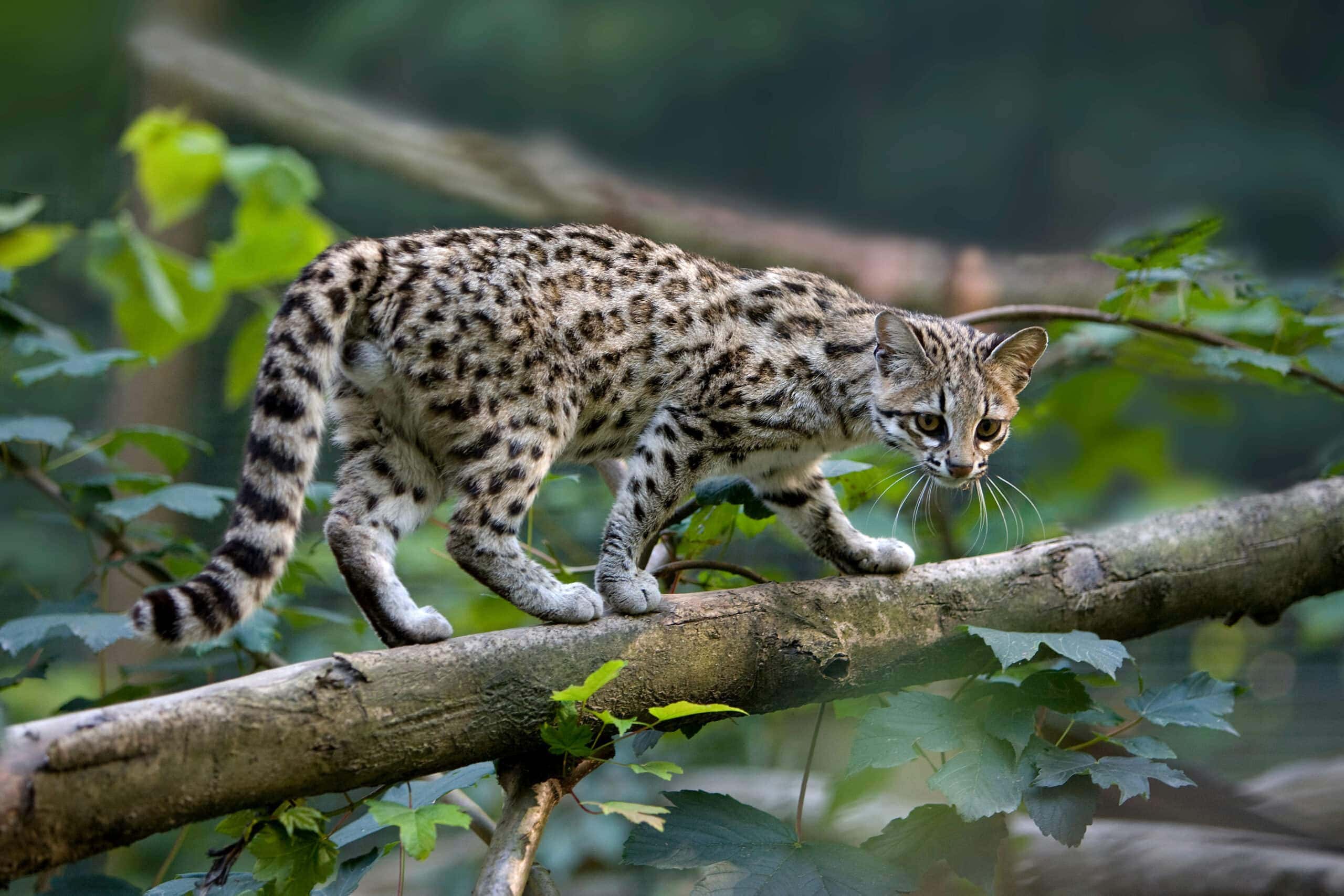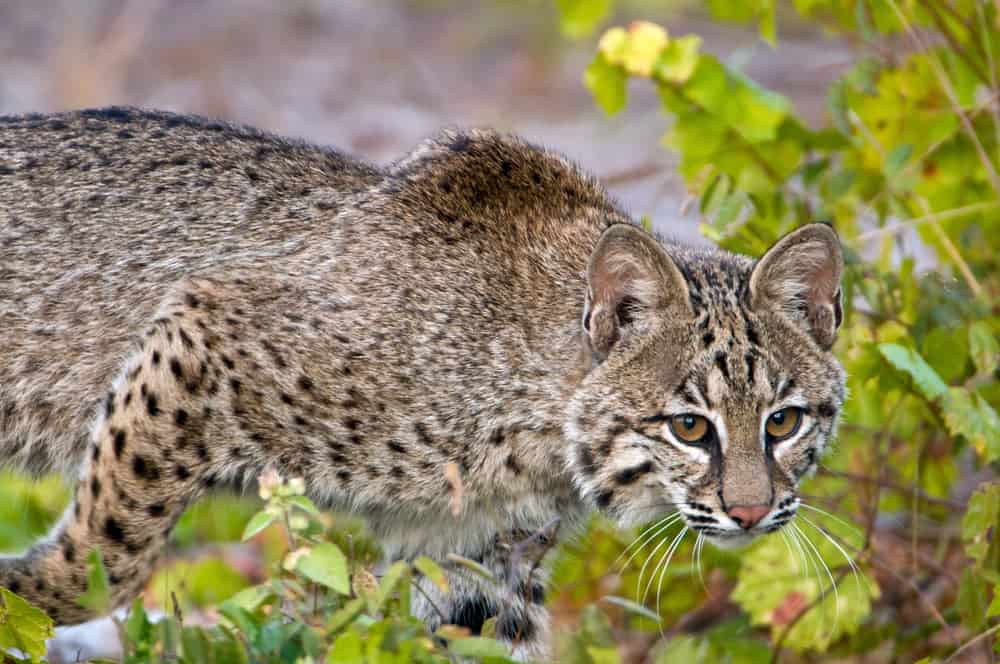As one of the largest U.S. states, Texas is rich in biodiversity, home to 160 types of reptiles, 71 types of amphibians, and 142 species of mammals. Texan wildlife includes wolves, armadillos, rat snakes, coyotes, white-tailed deer, and seven species of wild cat, three of which are endangered.
Texas wild cats play an important role in large herbivore population control. This helps maintain balance in the ecosystem by allowing vegetation to flourish and protecting bird and amphibian habitats. Read on to learn more about seven gorgeous Texan wild cats, past and present.

The 7 Types of Wild Cats in Texas
1. Ocelot

The Ocelot (Leopardus Pardalis) is a very striking wild cat with a coat featuring both stripes and spots. Every ocelot coat is unique, as no two are patterned exactly the same. Though they previously lived in Arkansas, Louisiana, and Arizona in addition to Texas, much of their former habitat has been destroyed. They now roam southern Texas near Brownsville and Harlingen and rainforests in South America.
Ocelots can grow up to between 30 and 41 inches in length and they typically weigh between 15 and 30 pounds, with males being heavier and larger than females. These nocturnal big cats’ prey includes rodents, iguanas, frogs, rabbits, and fish.
2. Bobcat

There are 12 subspecies of bobcats in the U.S., and the Lynx rufus texensis is the subspecies you’ll find in Texas. A close relative of the lynx (with whom the bobcat is often confused), bobcats can adapt to and survive in a number of habitats, including mixed forests, bottomland hardwood forests, coastal swamps, deserts, and scrublands. They can also adapt to life in urban areas.
Bobcats are around 35 inches long and males are around 26 pounds heavy, though females weigh in at approximately 20 pounds. Their coats are brown (sometimes red tinted) and they have brown or black spots or stripes. Bobcats can reach speeds of up to 30 miles per hour.
3. Jaguarundi

An endangered species, the jaguarundi (Herpailurus yaguarondi) is a very distinctive-looking wild cat that shares its south Texan habitat with Ocelots, though they can also be found in Mexico, Argentina, and throughout Central America. The jaguarundi descends from mountain lions and can survive in a variety of habitats including primary forest, savannah woodland, grasslands, and dry scrub.
Despite both living in the far south of Texas, the jaguarundi and the ocelot rules the roost and may prey upon the jaguarundi if the opportunity strikes. For this reason, the jaguarundi steers clear of the ocelot and is sometimes forced to live in unsafe areas as a result. The jaguarundi is brown or grey and weighs between 8 and 16 pounds. These cats have very distinctive facial features and rounded ears.
4. Margay

The margay is a near-threatened wild cat that is actually considered extinct in Texas but remains found over 100 years ago show that the margay did inhabit southern Texas thousands of years ago. Today, margays can be found in Central and Southern America, including Mexico, Uruguay, and Argentina.
The margay resembles the ocelot but has a smaller body and larger eyes. Margays stand at 2 feet tall and weighs between 5 and 12 pounds.
5. Mountain Lion

Mountain lions (Puma concolor) are also known as panthers, pumas, and cougars. The large yet slender mountain lion roams both western and southern Texas, with the western Texas population considered more stable due to its proximity to Mexico and New Mexico, from where mountain lions can migrate into Texas.
A large yet slender cat, mountain lions have long tails, small heads, rounded ears, and light brown coats. They also have black markings on their ears, nose, and the tip of their tails. These subtle wild cats are known for being solitary and reserved in nature. They’re not picky when it comes to habitat, as long as it’s well-covered. Mountain lions can be found in forests, deserts, wetlands, canyonlands, and mountains.
6. Jaguar

Jaguars (Panthera onca) are the largest cats in America (weighing between 80 and 300 pounds) with a unique method of killing their prey—by crushing its skull. These huge cats are considered extinct in Texas today, with the last recorded sighting in the 1940s, though they are sometimes seen in New Mexico and southern Arizona, having crossed over from Mexico. Today, they inhabit Mexico and Central America, with the largest population in Brazil.
A jaguar’s coat can be tawny or yellow and spotty or black, though black jaguars still have spots that can be seen in the right light conditions. They are incredibly agile and can reach speeds of up to 80 kilometers per hour. Their athleticism isn’t restricted to land, either—jaguars are competent swimmers, too.
7. Domestic Cat (Feral)

In addition to wild cats, it’s not uncommon to find feral cats and free-roaming cats hunting at night in Texas. This has caused some concern for Texan wildlife organizations due to fears that free-roaming domestic cats will damage the balance of the ecosystem by preying on declining or endangered species. These concerns also extend to the health and safety of the public and the feral cats themselves.

Frequent Asked Questions
What Is the Most Commonly Encountered Wild Cat in Texas?
In Texas, you are most likely to encounter a bobcat. Bobcats don’t prey on larger animals, but they may prey on smaller livestock like chickens and sheep if they’re hungry enough. That said, bobcats aren’t considered much of a threat to farmers.
Which Wild Cat Is the Most Dangerous in Texas?
Attacks on humans by big cats are uncommon in Texas. Even the largest, most powerful big cats like mountain lions are pretty reserved and, though they could easily take down a human, it’s highly unlikely that they would. Similarly, ocelots do not seek out humans as prey, preferring much smaller meals. Wild cats can be a threat to livestock and pets, though.

Conclusion
In this post, we’ve explored seven types of wild cats that currently exist in Texas or have roamed there at some point in the past. Despite their predatory natures, you’re pretty unlikely to encounter one of these cats yourself due to the fact that they hunt at night and tend to be reserved when it comes to humans.
Featured Image Credit: William Falla, Shutterstock
